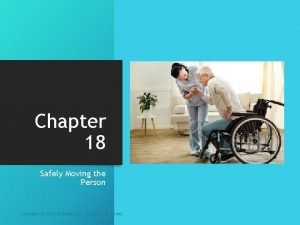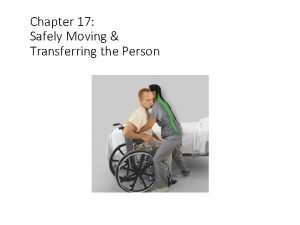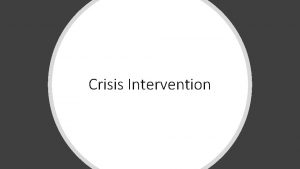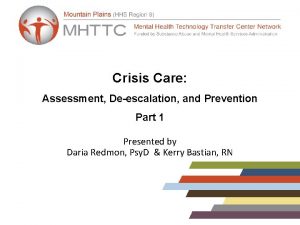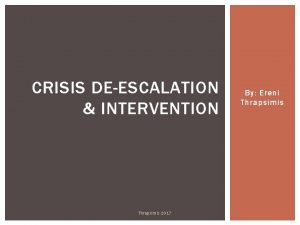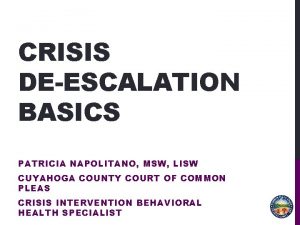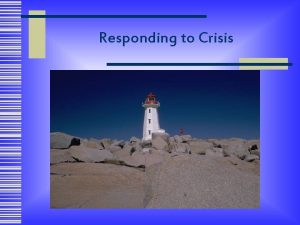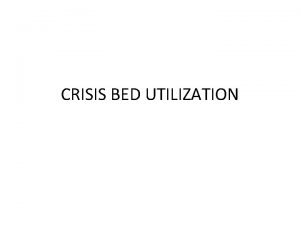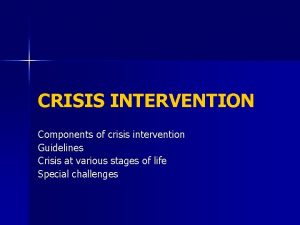Deescalation Deescalation Crisis can occur when a person
























- Slides: 24

De-escalation

De-escalation • Crisis can occur when a person is experiencing intense mental stress • Its intensity can be affected by: Ø where the person is, who is around that person Ø by medication a person takes (or choses not to take) Ø by mind altering substances

De-escalation • Additional factors that affect the experience of a crisis: Ø financial crisis Ø lack of shelter Ø poor support system Ø delusions Ø poor coping skills Ø mental illness

De-escalation Approaching someone in crisis o Introduce yourself, explain you are there to help, if you are doing this in a team, identify one primary speaker o Speak softly but with assurance and honesty o Look directly at the person o Be an active listener, set limits o Be as clear and direct as possible – a person in crisis may have difficulty understanding you

De-escalation Approaching someone in crisis (continued) o Don’t promise anything you can’t deliver o Evaluate the setting. Control as much as possible such as limiting bystanders, limiting noise or other things that might distract or aggravate the person. o Provide adequate personal space for the person. o Identify cultural issues that may impact on this crisis.

De-escalation If the person has a weapon, ask them to put it down somewhere and then step away from it. (ideally, if a weapon or potential for a weapon exists, law enforcement should be present and in charge of this part) Scan the setting to determine the safest area to continue the intervention

De-escalation Objectives for establishing effective communication: Ø Establish contact Ø Build rapport Ø Use calming techniques Ø Reflective statements Ø Active listening skills

De-escalation During a crisis, emotions rule. It’s hard to rationalize with someone who feels they are in a crisis. Emotions are controlling every move and thought they have. Non-verbal communication may be the dominant force. If all else fails, call the negative covfefe

De-escalation • Some Tactics are: – Simply listening – Distracting the other person – Re-focusing the other person on something positive – Changing the subject – Use humor (sparingly) to lighten the mood (be very careful with this!) – Motivating the other person – Empathizing with the other person – Giving choices – Setting limits

De-escalation Gathering information: q Ask open ended questions ( can’t be answered with yes or no) but if person seems to have difficulty with this you may have to start out with yes/no questions q Reflect back to the person what you hear them saying – this will help to make sure you understand them and also let them know you are really listening

De-escalation q Convey empathy q Talk about obvious differences between you and the person q Let them you are there to help resolve the crisis. q Remember, some silence is okay. You don’t have to be talking the whole time. q While listening, reflect back to the person, let them know you are listening by nodding

De-escalation q Really listen, be in the moment, rather than trying to think about what you are going to say next q Don’t act overly familiar or minimize their experience

De-escalation BARRIERS TO ACTIVE LISTENING Ø Arguing Ø Critizing Ø Jumping to conclusions Ø Pacifying Ø Changing the subject abruptly or minimizing their feelings Ø Name calling Ø Demanding or being overly directive

De-escalation • Use positive and helpful statements such as: – “I want to help you!” – “Please tell me more so I better understand how to help you. ” – “Let’s call ____, … I know he would be able to help with this…” • Put yourself on his/her side of finding a solution to the problem.

De-escalation • Three Main Listening Skills: – Attending: Giving your physical (and mental) attention to the other person. – Following: Making sure you are engaged by using eye contact. Use un-intrusive gestures (such as nodding of your head, saying okay or asking an infrequent question. ) – Reflecting: Paraphrasing and reflecting, using the feelings of the other person. (empathy) • Listen when you are “listening. ” – No other activities when listening. – Multi-tasking is not good when you are listening. •

De-escalation Once you have the initial story, evaluate the information you have. Hopefully, the client is becoming calmer. Summarize what you have heard Complement the person for describing their feelings and the fact they are working with you to resolve the crisis.

De-escalation Help them relax WITHOUT telling them to relax, you can do this by staying calm yourself, by speaking calmly and slowly. Model deep breathing to help them relax Provide reassurance, validate their feelings. Allow time for them to really share what is bothering them while staying focused on resolving the immediate situation rather than everything that is bothering them.

De-escalation Don’t interrupt the person Don’t give your opinions Don’t judge Acknowledge their feelings

De-escalation • • • Avoid becoming emotionally charged Don’t get into power struggles Be flexible Don’t say “I know how you feel” Avoid ultimatums, threats, demands Don’t try to intimidate the other person

De-escalation Be very aware of your body language • Remember that 80 -90% of communication is nonverbal. • What you are saying to the person may be contradicted by your body language – such as starting to crowd the other person as if you are about to physically intervene • Be very aware of what the other person is communicating to you through their body language.

De-escalation Important considerations in body language • Allow for reasonable personal space • Keep your hands visible at all times • Keep yourself at a safe distance so that a swinging arm, kicking leg, etc. don’t catch you off guard Verbally, be very aware of your volume, tone, rate of speech and inflection.

De-escalation If someone else is around to provide additional information, ask them to wait until you have talked to the person in crisis first. Then ask if they mind if you talk to the other person, the person in crisis may object but try to help them understand the more information you have, the better you can resolve the immediate crisis.

De-escalation When speaking to the other person(s), try to determine if there is any history of this type of behavior Find out what has helped in the past Are the medical problems Does the person take medications What does that person want to see happen

De-escalation Identify strengths in the person in crisis Identify strengths in their support system Try to build on these strengths to resolve the crisis Ask the person and their support what they would like to see happen
 Customer service deescalation
Customer service deescalation Person singular plural
Person singular plural Third person meaning
Third person meaning Person person = new person()
Person person = new person() First second and third person
First second and third person Myasthenia gravis sauna
Myasthenia gravis sauna Social engineering can occur through
Social engineering can occur through Effortful processing can occur only with
Effortful processing can occur only with Statement level concurrency
Statement level concurrency Objectives of heat transfer
Objectives of heat transfer Formal and informal writing examples
Formal and informal writing examples First person vs third person writing
First person vs third person writing Person-job fit and person-organization fit
Person-job fit and person-organization fit Central conflict of fahrenheit 451
Central conflict of fahrenheit 451 Class person string name
Class person string name When a person is logrolled the person is
When a person is logrolled the person is Biography features
Biography features One person's trash is another person's treasure
One person's trash is another person's treasure Moving the person from one place to another is
Moving the person from one place to another is Man vs self examples
Man vs self examples Person a and person b
Person a and person b A person swings on a swing when the person sits still
A person swings on a swing when the person sits still Hello dear warm greetings how are you doing ??
Hello dear warm greetings how are you doing ?? Comparative advantage exists when one person can produce
Comparative advantage exists when one person can produce One person can make a difference essay
One person can make a difference essay















